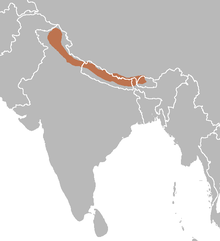Himalayan musk deer
| Himalayan musk deer | ||||||||||||
|---|---|---|---|---|---|---|---|---|---|---|---|---|
| Systematics | ||||||||||||
|
||||||||||||
| Scientific name | ||||||||||||
| Musk leucogaster | ||||||||||||
| Hodgson , 1839 |
The Himalayan musk deer ( musk leucogaster ) is a type of musk deer (Moschidae). It is common on the southern slopes of the Himalayas in northwest and northeast India, Nepal, and Bhutan.
features
The Himalayan musk deer is a relatively large musk deer and reaches a body length of 86 to 100 cm, has a tail 4 to 6 cm long and weighs 13 to 18 kg. The skulls measured so far were 15.3 to 16 cm long. In western Nepal the animals show a brown-yellowish, slightly streaky color on their back. The head is gray-brown, the ears are gray with whitish-gray edges and a whitish-gray interior. The abdomen, the chest and the underside of the lower jaw are also whitish-gray. The legs and throat are dark. Some individuals have whitish-gray circles under the eyes. The bases of the back hair are white. Young animals are spotted.
At Zhangmu (28 ° N, 87 ° E), in the forest zone of southern Tibet, the animals are darker, also have dark ears and their rear part is whitish-orange. The nasal bone of these animals is extended forward. In Khumjung , the neck of the musk deer is lighter, the throat is light, the chin and the underside of the lower jaw are creamy white, and the ears are gray at the base and black at the top. The legs and throat are black, the buttocks are yellow-brown and the belly is more gray than in the shape first described here. The skulls of both forms also differ. In northern Himachal Pradesh near Kullu and in the neighboring Nepalese regions there is a form ("pepper and salt form") that often shows a brown or reddish-aguti-colored (ie the hair is banded), lightly speckled color on the back takes the shape of a saddle. The throats of these animals are light brown with some light gray or whitish streaks that run from the throat to the inside of the front legs. The underflows are speckled white and therefore lighter than the trunk. The buttocks and tail are light-colored, the ears dark gray or brown with white edges. The belly is brown and lighter than the rest of the torso. The head is gray with white spots and orange spots above and below the eyes. These three forms could be subspecies of the Himalayan musk deer or musk deer species in their own right. So far, field studies have only been carried out with the “pepper and salt form”.
Habitat and way of life
The Himalayan musk deer is found in evergreen oak and birch forests on the slopes of the Himalayas. South of Mount Everest the animals live at altitudes of 3000 to 4300 meters, in Sikkim they occur between 2500 and 4400 meters and in Bhutan and Arunachal Pradesh their habitat is at an altitude of 2600 to 3000 meters in a dense bamboo forest . The animals usually stay in areas with a slope of 30 to 40%. During the day, Himalayan musk deer are mainly on the sunlit southern slopes and the night they spend sheltered in the bushes. They spend about 40% of their time active, especially at night, and 60% of their time resting or sleeping. In winter, Himalayan musk deer feed about 40% on leaves (half of it rhododendron leaves ), 16% on herbs (half of it Senecio ), 7% on grass and 2% on ferns. In spring and summer, herbs and lichens are mainly eaten, and herbs and leaves in autumn. They are relatively quiet, but hiss in danger and squeak when attacked by a predator. When males interact aggressively with one another, they make rattling noises, which may be caused by rubbing their teeth against one another. Young animals make bleating noises to maintain contact with their mother. The escape distance of the males is very short and is usually only 15 to 20 meters. In autumn it increases to about 30 meters. On the run, they tend to look around quickly. Females are more cautious and flee a distance of about 100 meters before stopping and looking around. The gestation period is 196 to 198 days. Newborns have an average weight of 600 g. Twins are born one in six births. The rate of twin births is thus lower than with other musk deer, with the exception of the yellow-bellied musk deer ( musk chrysogaster ).
Systematics
The Himalayan musk deer was first scientifically described in 1839 by the British naturalist Brian Houghton Hodgson . As type locality was Cis and trans Hemelayan regions specified. Although the species has different fur colors depending on the region, no subspecies are distinguished. However, it is possible that the species could become split into two or more species in the future . The Kashmiri musk deer ( Musk cupreus ) is often seen as conspecific to the Himalayan musk deer.
Danger
The IUCN estimates the population of the Himalayan musk deer as endangered. In the 1980s there were said to have been only 30,000 animals and each year around 4,000 males were killed for the extraction of musk from humans, so that the population has declined by 50% over the last three generations.
supporting documents
- ↑ a b c d e Colin Groves : Family Moschidae (Musk-deer) in Don E. Wilson , Russell A. Mittermeier : Handbook of the Mammals of the World - Volume 2. Hoofed Mammals. Lynx Editions, 2011, ISBN 978-84-96553-77-4 , pages 336-348.
- ↑ musk leucogaster in the endangered Red List species the IUCN 2015 Posted by: Timmins, RJ & Duckworth, JW, 2014. Retrieved on January 24 of 2019.
